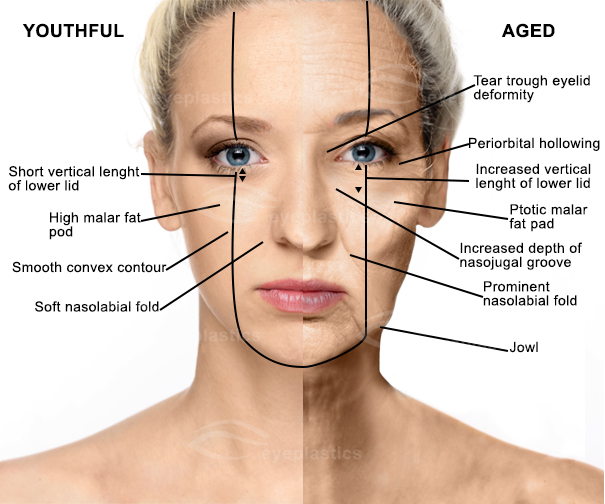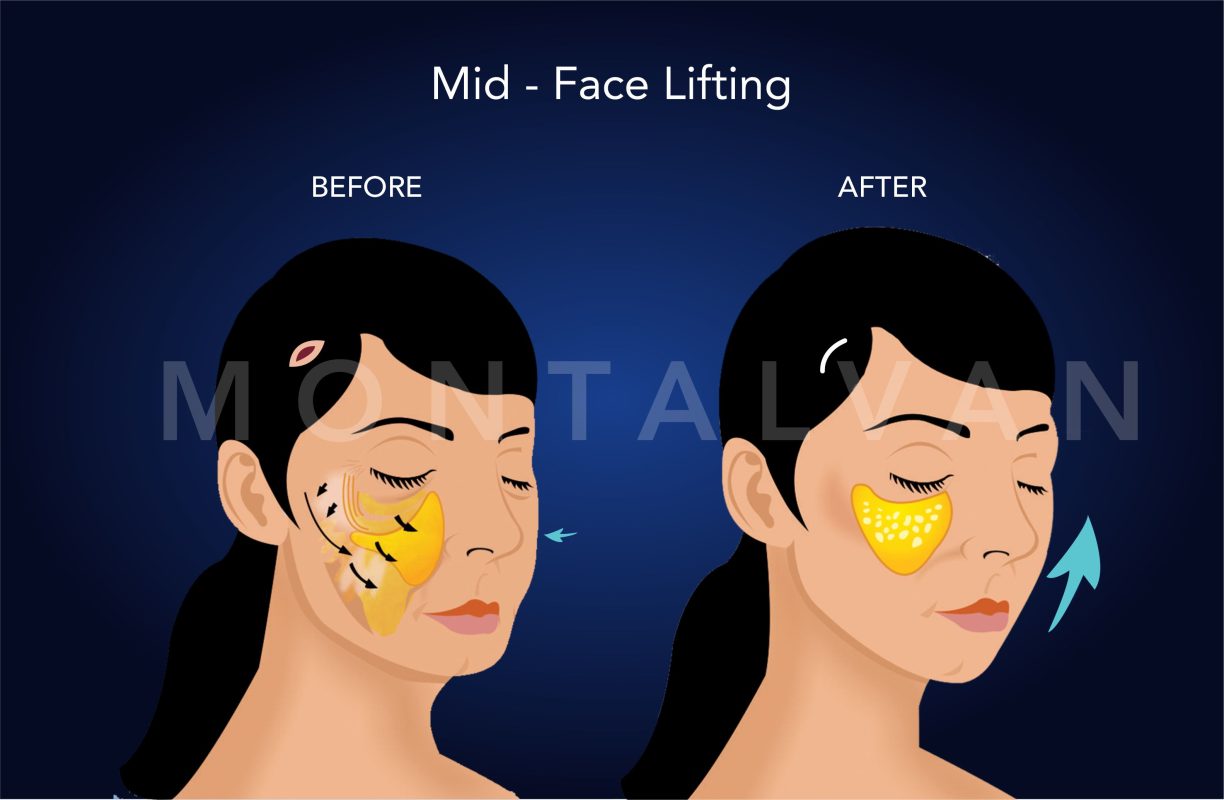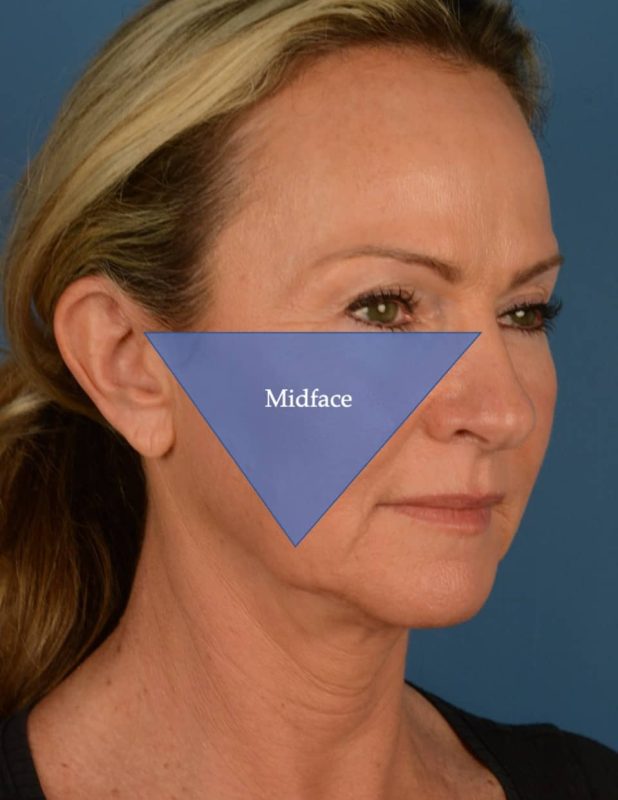Midface lift in Iran – Endoscopic, Endotine cheek lift
Midface lift in Iran, also known as a cheek lift in Iran, is a surgical procedure that targets the center part of the face. It aims to restore a youthful appearance by lifting the cheeks, reducing the appearance of deep nasolabial folds, and improving the lower eyelid contour.
What To Expect for cheek lift in Iran
A cheek lift, or midface lift, is a surgical procedure that aims to rejuvenate the middle portion of the face by lifting sagging cheeks, reducing deep laugh lines (nasolabial folds), and improving the contour of the lower eyelids.
Here’s what you can generally expect before, during, and after the procedure:
Before the Procedure
1. Consultation: You’ll meet with a plastic surgeon to discuss your aesthetic goals, medical history, and any concerns you have. The surgeon will explain the procedure, potential risks and benefits, and help you decide whether a cheek lift is right for you.
2. Preparation: If you decide to proceed, you’ll receive detailed instructions on how to prepare for surgery. This may include quitting smoking, avoiding certain medications that can increase bleeding, and arranging for someone to drive you home after the procedure.
During the Procedure
1. Anesthesia: The procedure is usually performed under general anesthesia, but in some cases, local anesthesia with sedation may be used.
2. Incisions: The surgeon will make incisions, often within the hairline or the mouth, through which the cheeks will be lifted. The specific technique will depend on your individual needs and the surgeon’s preferred approach.
3. Lifting and Securing: The surgeon lifts the sagging tissues and secures them in a higher position, often using sutures or a special device like an Endotine implant.
4. Closing Incisions: The incisions are then closed, typically with sutures.
After the Procedure
1. Recovery: Immediately after the surgery, you can expect some swelling, bruising, and discomfort. Pain can usually be managed with medications prescribed by your surgeon.
2. Post-operative Care: You’ll receive instructions on how to care for your incisions, and you’ll likely have follow-up appointments to monitor your progress.
3. Return to Normal Activities: Most people can return to work and normal activities within 1-2 weeks, though this can vary.
4. Final Results: The full results of your cheek lift may not be apparent until several months after the surgery, once all the swelling has subsided.
It’s important to remember that a cheek lift is a significant surgical procedure and, as such, carries risks such as infection, bleeding, and adverse reactions to anesthesia. Potential complications specific to cheek lifts could include nerve damage, changes in skin sensation, poor wound healing, unfavorable scarring, and dissatisfaction with the cosmetic results. Always consult with a board-certified plastic surgeon to ensure you have a full understanding of the procedure and what you can expect.
Type of Midface lift in Iran
There are several different types of midface lifts, each with its own techniques and benefits.
1. Traditional Midface Lift:
In a traditional midface lift, incisions are typically made in the hairline and within the mouth. The surgeon will then lift and reposition the fat and muscles in the cheek area. This method allows for a significant lift, but it involves a more extensive surgical procedure and longer recovery time compared to some other methods.
2. Endoscopic Midface Lift in Iran:
This less invasive method uses an endoscope (a thin tube with a light and camera on the end) inserted through small incisions in the hairline or inside the mouth. The surgeon uses the endoscope to guide small surgical instruments to lift the cheeks. This method typically results in smaller scars and a shorter recovery time.
3. Endotine Midface Lift in Iran:
This procedure uses a special bioabsorbable implant called an Endotine device. After making small incisions, the surgeon uses the device to lift and secure the midface tissues in a more elevated position. The device provides multiple points of fixation and is absorbed by the body over time.
4. Non-Surgical Midface Lift:
Also known as a liquid lift, this method uses injectable dermal fillers to add volume to the cheeks and reduce the appearance of nasolabial folds. While not a surgical lift, it can offer temporary improvement.
5. Thread Lift:
This minimally invasive procedure uses special threads inserted under the skin to lift the midface area. The threads have tiny barbs that grab and lift the sagging skin.
Each type of midface lift has its own advantages and potential drawbacks. Some people may find they get the best results from a combination of procedures. It’s important to consult with a board-certified plastic surgeon to discuss your goals and determine the best approach for you. The surgeon can explain the potential risks and benefits of each type of midface lift, and help you understand what outcome you can realistically expect.

Endotine cheek lift in Iran
An endotine cheek lift, also known as a midface lift in Iran, is a surgical procedure that aims to restore a youthful appearance to the middle part of the face. It involves elevating the tissues of the cheeks to improve the appearance of the lower eyelids, nasolabial folds (the lines extending from the nose to the corners of the mouth), and cheeks.
The term “Endotine” refers to a specific type of bioabsorbable implant that is often used in this type of procedure. The Endotine devices provide multiple points of fixation for the repositioned tissues, allowing for a more natural and balanced elevation than might be achieved with traditional sutures.
Cost of Endotine cheek lift in Iran
- The cost of Endocor Cheek Lift surgery in Tehran is between 2700 and 3500 euros
- Usually one night stay in the hospital is considered
- If you are not a resident of Tehran, the duration of stay in Tehran is 9 days
Endocor cheek lift surgery cost |
2900 euros |
including surgeon fee + hospital + implant purchase cost | |
| Other costs related to cheek lift surgery in Tehran | |||
| Cost of blood test | Between 10 and 15 euros | The difference depends on the type of blood test | |
| The cost of consultation with a cardiologist | Between 20 and 40 euros | For people over 40 or heart patients | |
| The cost of medicine and other health items | Between 10 and 20 euros | ||
| Cheek lift plastic surgery cost – optional | |||
| Nurse fee (per night) | 30 euros | If you are traveling alone | |
| The cost of changing the dressing by the nurse | |||
Attention:
- If you have an underlying disease or medication, let us know
- If you have already had facial surgery, the cost of the surgery will increase slightly
- Let us know if you have anemia or other blood disorders
Here’s a general outline of how the procedure might be performed:
1. Anesthesia: The procedure is usually performed under general anesthesia or intravenous sedation.
2. Incisions: Small incisions are made in the hairline or inside the mouth to allow for the insertion of the Endotine device.
3. Tissue repositioning: The tissues of the midface are gently elevated and repositioned to a more youthful position.
4. Insertion of Endotine device: The Endotine device is inserted through the incisions and used to secure the repositioned tissues in place. The unique design of the Endotine device allows for adjustments to be made to the position of the tissues even after they have been fixed in place.
5. Closure of incisions: The incisions are closed with sutures, and the procedure is complete.
It’s important to note that an Endotine cheek lift is a surgical procedure and, as such, it carries risks such as infection, bleeding, and adverse reactions to anesthesia. Recovery time can vary, but most people can expect to return to normal activities within a couple of weeks.
As with any cosmetic procedure, it’s important to have a detailed discussion with a board-certified plastic surgeon to fully understand the potential risks, benefits, and alternatives before deciding to proceed.
Endoscopic cheek lift
An endoscopic cheek lift, also known as endoscopic midface lift, is a less invasive procedure designed to lift the cheeks and rejuvenate the midface. The procedure aims to restore a youthful appearance by addressing sagging cheeks, deep nasolabial folds (the lines extending from the nose to the corners of the mouth), and under-eye bags. The endoscopic technique involves the use of a small camera (endoscope) and special surgical instruments, which allow for smaller incisions and potentially a quicker recovery compared to traditional surgical methods.
Here is a general outline of the procedure:
1. Anesthesia: The procedure is typically performed under general anesthesia or intravenous sedation.
2. Incisions: Small incisions are made within the hairline or inside the mouth, and sometimes in the lower eyelid. These allow for the insertion of the endoscope and surgical instruments.
3. Tissue repositioning: The surgeon uses the endoscope and instruments to gently elevate and reposition the tissues of the midface. This can help to reduce sagging and restore a more youthful contour to the cheeks and lower eyelids.
4. Fixation: The repositioned tissues are then secured in place using sutures or absorbable devices.
5. Incision closure: The incisions are closed with sutures, and the procedure is complete.
The potential benefits of an endoscopic cheek lift include smaller incisions, less visible scarring, and potentially a quicker recovery compared to traditional surgical methods. However, as with any surgical procedure, it carries risks such as infection, bleeding, and adverse reactions to anesthesia.
Recovery time can vary, but most people can expect to return to normal activities within a couple of weeks. There may be some swelling and bruising initially, which typically subsides over time.
As always, it’s important to consult with a board-certified plastic surgeon to discuss your individual needs and expectations, understand the potential risks and benefits, and determine the best treatment plan for you.
Recovery After cheek lift in Iran
Recovery after a cheek lift, or midface lift in Iran, can vary greatly depending on the specific technique used, the individual patient’s health, and the extent of the surgical procedure. Here’s a general idea of what you might expect during recovery:
1. Immediate Post-Operative Period: Immediately after the surgery, your face may be bandaged to minimize swelling and you may have drainage tubes in place. It’s common to experience some discomfort, swelling, and bruising. Pain can typically be managed with medications prescribed by your surgeon.
2. First Week: Swelling and bruising will peak within the first few days and then gradually subside. You may have some numbness in the face, which should also gradually decrease. Most patients are advised to keep their head elevated, even during sleep, and to avoid strenuous activity.
3. 1-2 Weeks: Stitches or staples, if used, are usually removed within 1 to 2 weeks. Most patients feel comfortable returning to work and social activities around this time, although this can vary. Some residual swelling may still be present.
4. 1-2 Months: By this time, most of the noticeable swelling should have subsided, and you can begin to see the results of your surgery. However, minor swelling and changes in sensation can persist for several months.
5. 3-6 Months: The final results of your cheek lift should be apparent. Residual numbness, if any, should resolve by this time.
It’s important to follow your surgeon’s post-operative instructions closely to ensure the best possible recovery. This includes taking prescribed medications, properly caring for incisions, and attending all follow-up appointments.
Any surgical procedure carries risks, such as infection, bleeding, and adverse reactions to anesthesia. Specific to cheek lift surgery, potential complications could also include nerve damage, changes in skin sensation, poor wound healing, unfavorable scarring, and dissatisfaction with the cosmetic results.
Consulting with a board-certified plastic surgeon and discussing your specific goals, health conditions, and any concerns you have is crucial. They can provide personalized advice and guide you through the recovery process.

Incisions endoscopic cheek lift
In an endoscopic cheek lift, or endoscopic midface lift, the surgeon uses an endoscope (a thin tube with a camera and a light on the end) to visualize the surgical area. This allows for smaller and fewer incisions, which can lead to a quicker recovery and less visible scarring compared to traditional open techniques.
Here are the typical locations for incisions in an endoscopic cheek lift:
1. Temporal Incisions: These are made within the hairline at the temples. This location helps hide the scars and allows the surgeon to lift the cheek vertically.
2. Lower Eyelid or Inside the Mouth Incisions: Some surgeons may also make small incisions either inside the lower eyelid or inside the mouth. These additional access points can allow the surgeon to better mobilize and lift the cheek tissue.
Through these incisions, the surgeon inserts the endoscope and small surgical instruments. The cheeks are then lifted and repositioned, and the tissue is secured in its new position using sutures or absorbable devices. The incisions are then closed with sutures.
The exact placement and number of incisions can vary depending on the specifics of the procedure and the surgeon’s preferred technique. As always, it’s important to have a thorough discussion with your plastic surgeon about the procedure, including incision placement and what kind of scarring you can expect.
Good candidate for cheek lift in Iran
A cheek lift, or midface lift, is a surgical procedure designed to restore a more youthful appearance by lifting sagging cheeks, reducing the appearance of deep nasolabial folds, and improving the contour of the lower eyelids. While the decision to undergo a cheek lift should always be made in consultation with a board-certified plastic surgeon, here are some general characteristics that might make you a good candidate:
1. Age and Skin Elasticity: While there’s no specific age requirement for a cheek lift, the procedure is most commonly performed on individuals in their 40s to 60s. Good skin elasticity can help achieve the best results, as the skin needs to be able to re-drape smoothly over the lifted underlying tissues.
2. Signs of Aging: Good candidates are typically those who have noticeable sagging of the cheeks and deep nasolabial folds. They may also have hollows under the eyes or sagging lower eyelids.
3. Health: Ideal candidates should be in good overall health. This means they should not have any serious medical conditions that could increase the risk of complications during or after surgery. They should also be non-smokers, as smoking can hinder the healing process.
4. Realistic Expectations: It’s important to have realistic expectations about what a cheek lift can achieve. While the procedure can significantly improve signs of aging in the midface, it won’t eliminate all facial aging and it may not be able to address issues in other areas of the face.
If you’re considering a cheek lift, the best place to start is by consulting with a board-certified plastic surgeon. They can evaluate your individual circumstances, discuss your aesthetic goals, and help you understand whether a cheek lift or another procedure might be the best fit for you.

